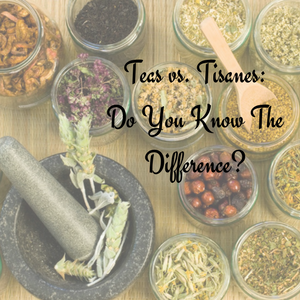
Key Blog Takeaways:
1. **Definition of Tea and Tisanes**: True tea comes exclusively from the leaves of the Camellia sinensis plant. Herbal teas, also known as tisanes, are infusions made from leaves, roots, berries, and spices of other plants and do not contain Camellia sinensis leaves.
2. **Varieties of Tisanes**: Tisanes can be categorized based on the part of the plant they come from. Examples include leaf tisanes (peppermint, lemongrass), flower tisanes (rosehips, chamomile, hibiscus, lavender), bark tisanes (cinnamon, black cherry), root tisanes (ginger, licorice), fruit/berry tisanes (raspberry, blueberry, peach, apple), and seed/spice tisanes (cardamom, fennel).
3. **Blended Tisanes**: Many tisanes are mixed blends of various dried fruits, berries, herbs, flowers, and roots. Examples provided include Ginger's Island (apples, coconut, pineapple, rose hip, hibiscus, lemongrass, ginger) and Last Mango In Paris (mango, orange, apple, hibiscus, rosehips).
4. **Plain Herbal Tisanes and Their Uses**: Plain herbal tisanes such as peppermint, ginger, lemongrass, rosehips, chamomile, hibiscus, and lavender are referred to as "blenders" because they can be steeped on their own or added to other teas to enhance flavors and aromas.
5. **Health Benefits and Caffeine-Free Nature of Tisanes**: Tisanes offer numerous health benefits and are caffeine-free, making them suitable for all-day consumption. Examples include rooibos for antioxidants, chamomile and lavender for calming effects, peppermint and ginger for digestion, and hibiscus for its super fruit properties.
Your Herbal Tea Isn't Really Tea
Herbal teas, also called tisanes, are a huge part of the tea world, but did you know they're not technically teas? Americans have a habit of referring to all leafy beverages steeped in hot water as tea, but that's not always the case.

Tea comes from the leaves of the Camellia Sinensis plant, a shrub native to regions of Asia. All teas, whether they be black teas like Earl Grey, green teas like Sencha Fuji or oolongs like Formosa, are derived from this one plant.
Tisanes (pronounced ti-zahn) are teas that don't contain leaves of the Camellia Sinensis. Instead they are infusions made from the leaves, roots, berries, and spices of other plants.
The Many Types of Tisanes
There are many various types of Tisanes. They are usually categorized by what part of the plant they come from such as leaf/herb, flower, bark, root, fruit/berry, and seed/spice. Here are some examples of the various types of tisanes:
- Leaf tisanes: peppermint, and lemongrass
- Flower tisanes: rosehips, camomile, hibiscus and lavender
- Bark tisanes: cinnamon and black cherry
- Root tisanes: ginger and licorice
- Fruit/berry tisane: raspberry, blueberry, peach and apple
- Seed/spice tisanes: cardamom and fennel
Our Tisanes
Many of our Tisanes are mixed blends of dried fruits, berries, herbs, flowers, and roots. For instance, our Ginger's Island is a blend of dried apples, coconut, pineapple, rose hip, hibiscus, lemongrass and ginger. Our Berry Berry tisane is a mix of blueberries, elderberries, raisins, hibiscus and rosehips. My favorite tisane is Last Mango In Paris, a luscious blend of mango, juicy orange and apple with flowery hints of hibiscus and rosehips.



We also carry some plain herbal tisanes including peppermint, ginger, lemongrass, rosehips, camomile, hibiscus, and lavender. We refer to those as our "blenders" because although you can steep them and drink them plain, you can also add them to other teas and give them more prominent flavors or aromas. For example add camomile to rooibos for a calming effect, or extra lavender to your favorite black tea for a stronger floral aroma.
Rooibos

You may have heard of Rooibos tea (pronounced roy-bus) the "red tea" from South Africa. Rooibos is brewed like tea, but is considered an herbal and comes from the root of an entirely different plant. You can find Rooibos plain, and mixed with various flavors and herbs including Belgian chocolate, caramel, and vanilla. To learn more about Rooibos check out this article here.
The Benefits of Tisanes
Besides being refreshing and fragrant, tisanes are loaded with health benefits. First of all tisanes, because they contain no actual tea, have zero caffeine so they have no diuretics effects and you can drink them all day long! They are also full of health benefits; for example rooibos is full of antioxidants, camomile and lavender have calming effects, peppermint and ginger are good for digestion, and hibiscus is super fruit!
Don't be fooled, know your tea, and if you're still a little confused stop in and discover the differences between teas and tisanes yourself!
Below are a couple more examples of our lovely tisanes!
